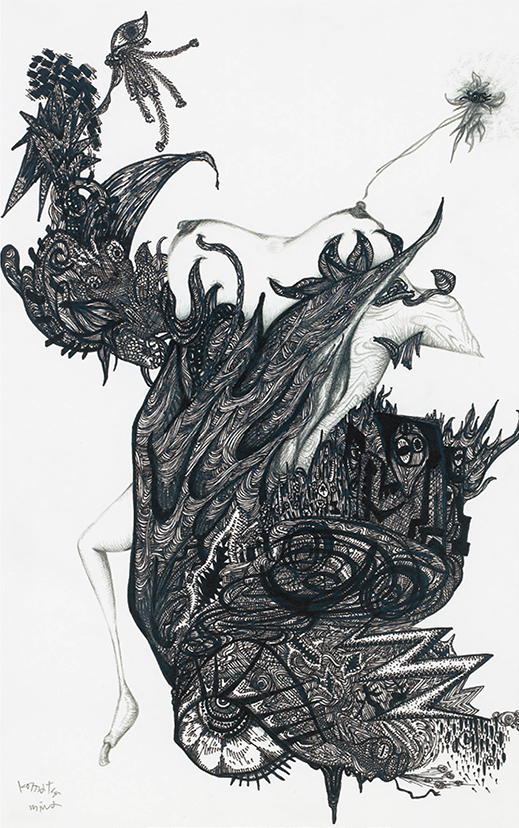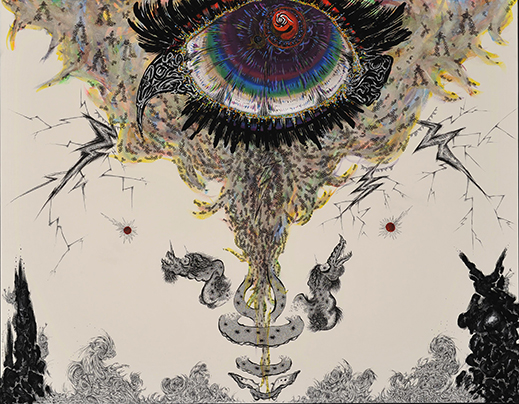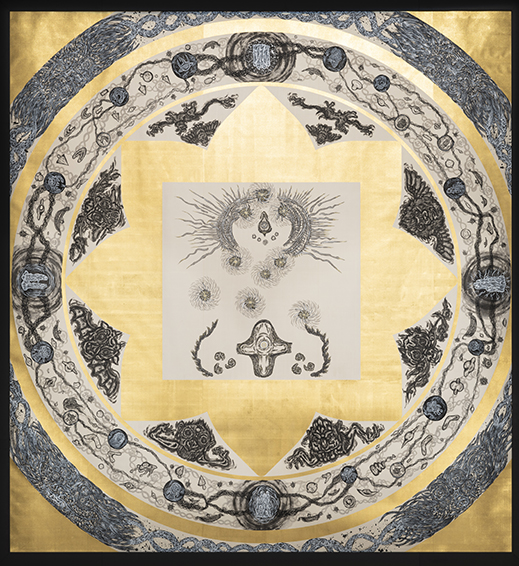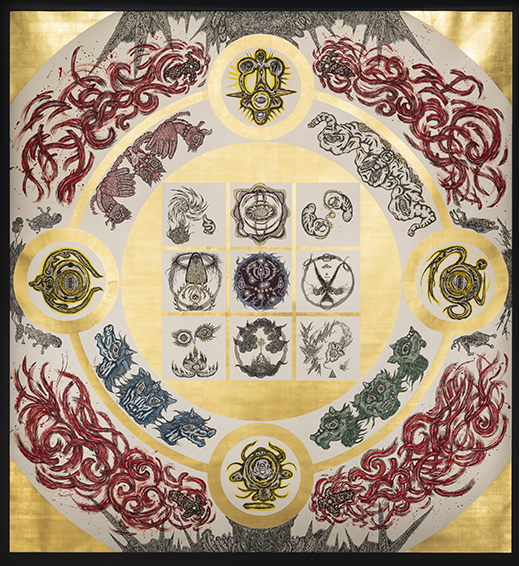| |
|
Here and There introduces art, artists, galleries, museums, and other cultural facilities around Japan that non-Japanese readers and first-time visitors may find of particular interest.
|
|
 |
|
|
 |
 |
The Eyes Have It: The Spirit-Visions of Miwa Komatsu
Alan Gleason |
 |
Three Guardians Gatekeeping the Heat and Cold (2021), canvas, acrylic; private collection |
When Miwa Komatsu was a young girl growing up in the Chikuma River valley of Nagano Prefecture, a yamainu "mountain-dog" spirit would appear and give her guidance when she was lost or late getting home. Wolf-like cousins to the horned canine komainu who guard Japanese shrines, yamainu have figured in the country's folklore since time immemorial. These and other creatures of myth populate Komatsu's art as guardians of, and guides to, the vast spiritual realm that humans all too rarely access. For Komatsu, the world of the spirits is not just a source of inspiration, but the very wellspring of her art, and giving it visual form appears to be her mission in life.
Such a devotion to visionary motifs is rare enough among contemporary artists, but the intensity of Komatsu's portrayals is, for lack of a better term, mind-blowing. Until the end of August the Taro Okamoto Museum of Art in Kawasaki is offering a thorough retrospective of the artist's career to date, and although Komatsu is still in her late thirties, the quantity, scale, and force of her output make the exhibition an emotionally exhausting experience. Through canvas after canvas parade a pantheon of wild, hairy, bug-eyed creatures whose ferocity belies the benign role they play in Komatsu's worldview. Those terrifying orbs stare into the human soul, illuminating our weaknesses and prodding us to pursue a meditative practice that will help us grow the "third eye" that enables us to perceive the universe as it really is.
|
Pray for Prosperity: Born of Love, Prosper with Love (2016), canvas, acrylic, box; private collection
|
|
The Entity Stirs (2016), canvas, mixed media; private collection |
Komatsu describes her own development as an artist as propelled by a series of epiphanies, both worldly and spiritual. Early on she was captivated by line drawings in picture books, and when she learned that many of these were copperplate prints, she immersed herself in printmaking. Works from her art-school years and early twenties hint at themes to come, but the images therein seem to derive from the nightmares of a psyche tormented by corporeal fears and desires. Densely etched in black and white, with elements of the erotic and the grotesque, they share something of the dark weirdness of the creatures conjured up by Odilon Redon.
 |
|
 |
|
|
|
|
Life and Death (2005), copperplate print; collection of the artist
|
|
Vortex of Worldly Desires (2011), paper, pen, pencil; private collection |
By her mid-twenties, Komatsu's work -- particularly a powerful print titled Until the 49th Day after Death (2005) -- was already earning her accolades, but when she traveled to New York at 26 she was shocked to find that prints, with their infinite reproducibility, were considered a lesser art form than painting. In a bridge-burning gesture she chopped the plate for Until the 49th Day in half, and began painting with acrylics. Just as significant as the change in medium is the fact that she was now using color, which she had eschewed as a printmaker.
The chronological ordering of the works in this show allows us to see the quantum leaps in technique and expression Komatsu made over the next few years. Her first paintings are still largely monochromatic, mostly black with tentative touches of color. Soon enough, though, they transform into a riot of primary-hued supernatural creatures that threaten to leap off the canvas, their eyes (bigger and buggier than ever) exploding like roman candles. Her brushwork, too, grows noticeably freer and more fluid, her creativity now virtually unfettered.
 |
|
Shin-Fudoki (2014), paper, acrylic, sumi ink, pen, diamond; Izumo Taisha Shrine |
During this period Komatsu was increasingly drawn to worship at such "power spots" of indigenous Japanese religion as the Ise and Izumo shrines. At Izumo, she saw a rainbow rising over the sanctuary, the seeming embodiment of "the rainbow-colored prayers of people ascending to Heaven." Experiences like this prompted her to make the rounds of shrines and temples throughout Japan, painting on-site and dedicating the results as a votive contribution. She also traveled to Thailand, where she underwent meditation training in a cave and found herself face to face with "spirits and entities" whose gazes penetrated her soul and, in her words, found it wanting. The priest who was guiding her practice told her that this signified the opening of her own third eye, an experience that, she says, had the effect of expanding her perspective on painting as well as life. One practical consequence was a new urge to work in three dimensions, and she began turning out a series of delightful porcelain yamainu and komainu in collaboration with Arita-ware ceramists.
In the last couple of years, Komatsu seems to have achieved a plateau of inner peace and artistic accomplishment that is reflected in broader themes of spiritual purity and harmony. These have a decidedly Buddhistic tinge, perhaps reflective of the fact that the artist has been spending a lot of time at Koyasan, the mountaintop temple complex belonging to the Shingon school of Esoteric Buddhism. There and at Toji, a Shingon temple in Kyoto, she has painted a series of mandalas that form the centerpiece of the current show. After passing through galleries covering the successive periods of her career to date, one enters a vast, darkened, high-ceilinged hall where two monumental mandalas face each other from opposite walls. Jointly titled Next Mandala - The Great Harmonization, these are modeled after the Diamond and Womb Mandalas that are the hallmark of Shingon iconography. Komatsu's mandalas, however, contain virtually no Buddha figures; instead they feature arrays of abstract symbols that came to the artist in visions, enclosed by concentric circles filled with frolicking yamainu and helical strands of what might be DNA. The impression is not so much of the cosmos in microcosm as of a pair of massive unicellular organisms.
 |
|
 |
|
|
|
Next Mandala - The Great Harmonization (2022), left and right, paper on scroll; collection of the artist (to be dedicated to Toji temple on 8 October 2023) |
Between the two great mandalas sits a large installation that is a sort of collaboration between Komatsu and Taro Okamoto (1911-96), the legendary avant-gardist to whose work the museum is dedicated. Occupying the center is Taro's large 1962 bronze sculpture Chaos, around which Komatsu has laid out helices (here the DNA reference is more overt) of obsidian. Titling her work Obsidian - Transparent Chaos, she explains that the glossy black rock was used by the earliest inhabitants of the Japanese archipelago to fashion tools, and is thus emblematic of the harmony that once existed between humanity and nature. The possibility, indeed the necessity, of achieving that harmony once again is a theme underpinning near all of Komatsu's recent work. For inspiration she has been studying the Jomon culture that predominated in Japan for some 14,000 years until shortly before the advent of the Common Era. One of the major Jomon population centers was the mountainous region of central Honshu where Komatsu grew up, not far from one of the largest obsidian deposits in the archipelago.
Taro Okamoto is also known for his fascination with Jomon artifacts and his incorporation of Jomon motifs into his own work. So it makes perfect sense that the museum would host this retrospective of work by Komatsu, a kindred spirit in that regard, and invite her to "collaborate" with her late predecessor. For her part, Komatsu says Taro inspired her with his belief that myth is a force of the future, not the past, as expressed in the title of his famous mural Myth of Tomorrow. (You can see this work in the review of a Taro retrospective in Osaka in this month's Focus.) The title of Komatsu's new work Legends in the Future Tense (2022) expresses her affinity for the same notion. A meters-long mural that greets you as you first enter the exhibition, it is an awesome production. Here a cavalcade of Komatsu's totemic spirits flanks a pair of enormous eyes. But unlike past works that featured similar motifs in explosions of color, this one employs the same subdued blend of black ink and gold leaf one sees in her mandalas. The impact, though no less forceful, feels gentle and contemplative -- a sign, perhaps, that Komatsu is entering a more tranquil phase in her life and work.
 |
|
Legends in the Future Tense (2022), canvas, acrylic; collection of the artist |
All works by Miwa Komatsu; all images courtesy of Fudo Co., Ltd.
|
 |
| Miwa Komatsu / Transparent Chaos: Spirituality and Mandala (in Japanese only) |
| 25 June - 28 August 2022 |
| Taro Okamoto Museum of Art |
7-1-5 Masugata, Tama-ku, Kawasaki, Kanagawa Prefecture
Phone: 044-900-9898
Hours: 9:30 a.m. to 5 p.m., last entry 30 minutes before closing (reservations required)
Closed Mondays (or Tuesday when Monday is a national holiday), the day after national holidays, and year-end holidays
Access: 17 minutes' walk from the south exit of Mukogaoka-Yuen Station on the Odakyu Line, 20 minutes from Shinjuku by express
|
|
|
|
| |
 |
Alan Gleason
Alan Gleason is a translator, editor and writer based in Tokyo, where he has lived for over 30 years. Since 2006 he has edited artscape Japan and written the Here and There column, as well as translating the Picks reviews. He also edits and translates works on Japanese architecture, music, and theater. |
|
|
|
|
|
|
|
|
|
 |
|